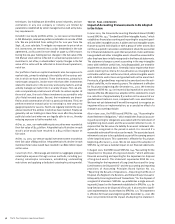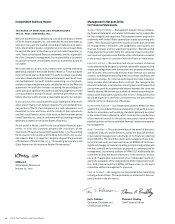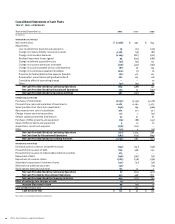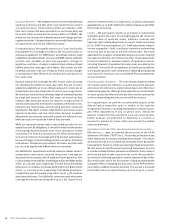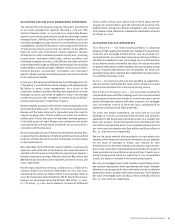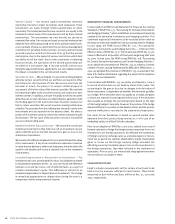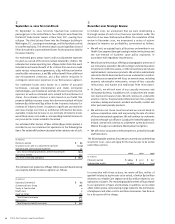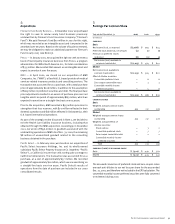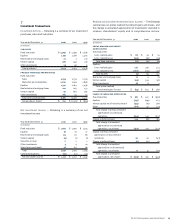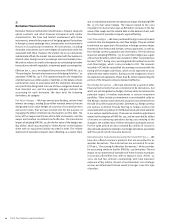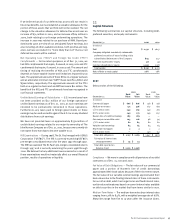Travelers 2001 Annual Report Download - page 50
Download and view the complete annual report
Please find page 50 of the 2001 Travelers annual report below. You can navigate through the pages in the report by either clicking on the pages listed below, or by using the keyword search tool below to find specific information within the annual report.
The St. Paul Companies 2001 Annual Report48
Venture Capital — Our venture capital investments represent
ownership interests in small- to medium-sized companies. These
investments are made through limited partnerships or direct
ownership. The limited partnerships are carried at our equity in the
estimated market value of the investments held by these limited
partnerships. The investments we own directly are carried at
estimated fair value. Fair values are based on quoted market prices
obtained from third-party pricing services for publicly traded stock,
or an estimate of value as determined by an internal management
committee for privately-held securities. Certain publicly traded
securities may be carried at a discount of 10-35% of the quoted
market price, due to the impact of various restrictions which limit
our ability to sell the stock. Due to time constraints in obtaining
financial results, the operations of the limited partnerships are
recorded on a one-quarter lag. If security-specific events occur
during the lag period that are significant to our consolidated results,
the impact is included in the current period results.
Securities on Loan — We participate in a securities lending program
whereby certain securities from our portfolio are loaned to other
institutions for short periods of time. We receive a fee from the
borrower in return. Our policy is to require collateral equal to
102 percent of the fair value of the loaned securities. We maintain
full ownership rights to the securities loaned, and continue to earn
interest on them. In addition, we have the ability to sell the securities
while they are on loan. We have an indemnification agreement with
the lending agents in the event a borrower becomes insolvent or
fails to return securities. We record securities lending collateral as
a liability. The proceeds from the collateral are invested in short-term
investments and are reported on the balance sheet. We share a
portion of the interest earned on these short-term investments with
the borrower. The fair value of the securities on loan is reclassified
as a securities lending asset.
Realized Investment Gains and Losses — We record the cost of each
individual investment so that when we sell an investment, we are
able to identify and record that transaction’s gain or loss on our
statement of operations.
We monitor the difference between the cost and estimated fair value
of our investments. If any of our investments experience a decline
in value that we believe is other than temporary, we write down the
asset for the decline and record a realized loss on the statement
of operations.
Unrealized Appreciation or Depreciation on Investments — For
investments we carry at estimated fair value, including those related
to discontinued operations at Dec. 31, 2000, we record the difference
between cost and fair value, net of deferred taxes, as a part of
common shareholders’ equity. This difference is referred to as
unrealized appreciation or depreciation on investments. The change
in unrealized appreciation or depreciation during the year is a
component of other comprehensive income.
derivative financial instruments
In June 1998, the FASB issued Statement of Financial Accounting
Standards (“SFAS”) No. 133, “Accounting for Derivative Instruments
and Hedging Activities,” which establishes accounting and reporting
standards for derivative instruments and hedging activities. This
statement required all derivatives to be recorded at fair value on
the balance sheet and established new accounting rules for hedging.
In June 1999, the FASB issued SFAS No. 137, “Accounting for
Derivative Instruments and Hedging Activities — Deferral of the
Effective Date of SFAS No. 133,” which amended SFAS No. 133 to
make it effective for all quarters of fiscal years beginning after June
15, 2000. In June 2000, the FASB issued SFAS No. 138, “Accounting
for Certain Derivative Instruments and Certain Hedging Activities,”
as an additional amendment to SFAS No. 133, to address a limited
number of issues causing implementation difficulties. Effective Jan. 1,
2001, we adopted the provisions of SFAS No. 133, as amended. See
Note 8 for further information regarding the impact of the adoption
on our financial statements.
In accordance with SFAS No. 133, our policy as of January 1, 2001 is
to record all derivatives on our balance sheet at fair value. The
accounting for the gain or loss due to changes in the fair value of
these instruments is dependent on whether the derivative qualifies
as a hedge. If the derivative does not qualify as a hedge, the gains
or losses are reported in earnings when they occur. If the derivative
does qualify as a hedge, the accounting varies based on the type
of risk being hedged. Generally, however, the portion of the hedge
deemed effective is recorded on the balance sheet, and the portion
deemed ineffective is recorded in the statement of operations.
Fair value for our derivatives is based on quoted market rates
obtained from third party pricing services or, in the case of an
embedded collar, on a Black Scholes valuation.
Prior to our adoption of SFAS No. 133 in 2001, related to our use of
forward contracts to hedge the foreign currency exposure to our net
investment in our foreign operations, we reflected the movements
of foreign currency exchange rates as unrealized gains or losses,
net of tax, as part of our common shareholders’ equity. If unrealized
gains or losses on the foreign currency hedge exceeded the
offsetting currency translation gain or loss on the investments in
the foreign operations, they were included in the statement of
operations. Prior to 2001, our interest rate swap agreements were
not recorded on our balance sheet.
cash restrictions
Lloyd’s solvency requirements call for certain of our funds to be
held in trust in amounts sufficient to meet claims. These funds
amounted to $76 million and $102 million at Dec. 31, 2001 and
2000, respectively.


